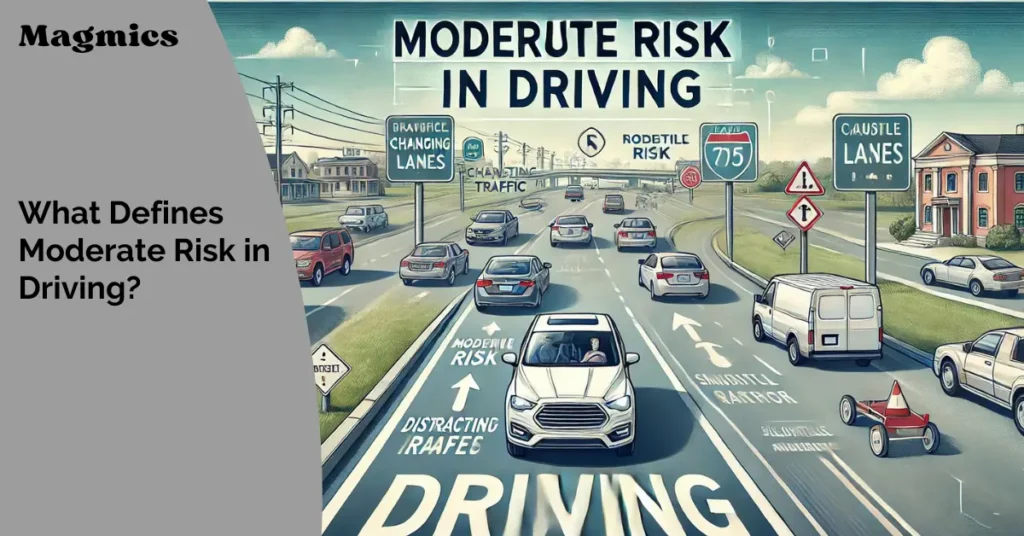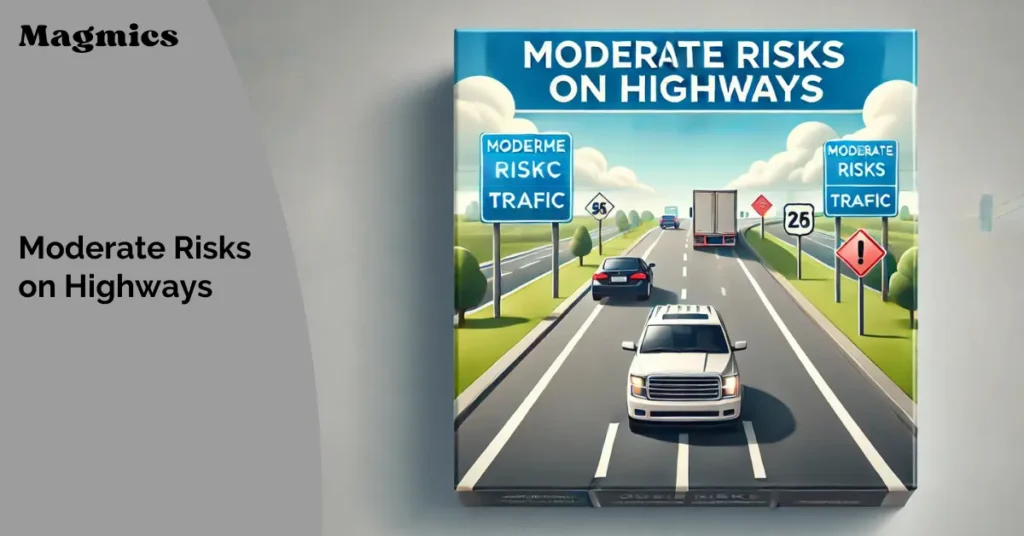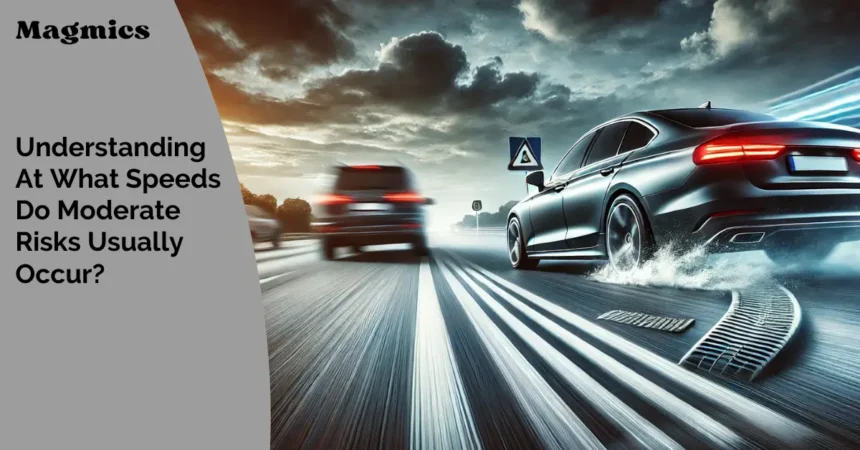At What Speeds Do Moderate Risks Usually Occur? Driving can be dangerous depending on how fast you go and where you are. Some speeds feel safe but can still have risks.
Let’s look at what moderate risk means, when it happens, and what affects it. By knowing at What Speeds Do Moderate Risks Usually Occur; you can drive more safely everywhere.
Key Points:
- Moderate risks happen most often at speeds between 30-50 mph.
- Change your speed based on the road and how well you can see.
- Slower speeds help you react and stay in control.
- Be careful, even if the speed feels safe.
- Leave enough space between your car and others to avoid accidents.
What Defines Moderate Risk in Driving?

Moderate risk means there’s a chance of accidents or unsafe situations, but it’s not as high as “high risk.” For example, driving at 40 mph in an area with pedestrians could pose moderate risks as stopping or reacting becomes more difficult.
It means being careful is important, but the danger isn’t as big as high risks. It’s a level where staying alert and controlling your speed can prevent most issues.
At What Speeds Do Moderate Risks Usually Occur?
Understanding the speeds At What Speeds Do Moderate Risks Usually Occur can help you drive more safely.
- Risks may become moderate around 30 to 50 mph, especially in urban and suburban areas.
- Speeds of 50–65 mph on highways might also present moderate risks depending on traffic and visibility.
Here’s the key idea—your surroundings affect how risky your speed is.
How Does Speed Influence Risk Levels?
The faster you go, the less time you have to react. Higher speeds make it harder to stop quickly, avoid accidents, or control your vehicle.
| Speed (mph) | Risk Level |
| Under 20 mph | Low risk in controlled areas |
| 30–50 mph | Moderate risk in urban areas |
| Over 70 mph | High risk, especially on curves |
The Role of Driving Environment in Risk Levels
The driving environment affects how safe your speed is.
Residential Areas
Driving over 25 mph in neighborhoods is risky. Kids, pets, or people might suddenly cross. Parked cars can block your view, making it hard to see clearly.
Highways
When traffic is heavy, driving faster than 50 mph can be dangerous. Cars stop or merge quickly, and it’s harder to keep enough space between vehicles.
Urban Streets
City roads have walkers, bikes, and lots of cars. Driving at 30 mph gives you time to stop for people or react to cars turning suddenly.
Suburban Zones
Driving over 40 mph in the suburbs can be risky. Parked cars, cyclists, or sharp turns can appear suddenly, making it harder to drive safely.
Empty Parking Lots
Even in parking lots, go slow, around 10-15 mph. Cars may back out, or people might walk in your path.
Why Moderate Risks Usually Occur at Certain Speeds?
At What Speeds Do Moderate Risks Usually Occur? Moderate risks occur at middle speeds because they often feel “safe” when they need more caution. For instance, driving 45 mph may feel reasonable on a winding road until a sharp curve appears suddenly.
At these speeds, you might not have enough time to react to sudden changes. Things like pedestrians, other cars, or sharp turns can quickly turn safe driving into a risky situation.
What Factors Contribute to Moderate Risk?
Even at regular speeds, many factors can contribute to risky driving. Being aware of these risks can keep you safe.
Speed
It is difficult to stop fast when driving too fast. Additionally, driving too slowly can cause issues and confuse other drivers. Always drive at a safe speed and remain careful.
Traffic Situations
Your automobile may slip or lose control on poor roads, such as those with holes or ice. Even if you are driving carefully, wet roads after rain can be quite slick.
The weather
Snow, fog, or rain can make it difficult to see other vehicles or the road. Because it takes longer to stop on wet or snowy roadways, accidents may result.
Traffic Volume
There is less room between cars on busy roadways. It may be more difficult to react and stop safely if traffic stops suddenly.
Distractions for Drivers
Driving while eating, talking, or staring at your phone can cause you to lose concentration.
How Road Conditions Impact Moderate Risks
Wet, icy, or uneven roads raise your risk at any speed. For example, driving at 40 mph during rain could make stopping harder, shifting risk from moderate to high.
| Road Condition | Safe Speed Range (mph) |
| Dry and clear | 25–50 mph |
| Wet or rainy | 15–40 mph |
| Icy or snowy | Under 20 mph |
Is Speed Limit Always the Safest Option?
Not always! Speed limits are made for normal road and weather conditions. If it’s raining, foggy, or the road is icy, driving slower than the limit is safer. In busy areas like school zones or near crowded streets, going below the limit gives you more time to stop if something happens.
Even if the sign says 50 mph, it’s better to slow down if the road feels unsafe. Remember, staying safe is more important than following the exact speed limit.
Understanding Risk Levels in Urban and Suburban Areas
Driving safely in urban and suburban areas means adjusting your speed to match the conditions.
Urban Areas:
Speeds over 30 mph in busy city zones can create moderate risks. With lots of pedestrians, bikes, and cars, even a small mistake can cause problems. Intersections, crosswalks, and parked vehicles make it important to drive slowly and stay alert.
Suburban Areas:
In suburban areas, speeds around 40–50 mph might feel safe but can still be risky. These areas often have sharp turns, driveways, and mixed traffic like cyclists and cars. Visibility can also change suddenly due to parked cars or curves in the road.
Read Also: What option will not be available if you are behind on loan payments?
Moderate Risks on Highways

On highways, risks happen at speeds of 50–65 mph, especially if there is a lot of traffic or bad weather. At these speeds, it is harder to stop quickly if a car suddenly slows down or moves into your lane. Rain, fog, or other bad weather makes it harder to see and react in time.
Driving too fast can also make it easy to lose control, especially on sharp turns or wet roads. To stay safe, always pay attention and leave enough space between your car and others.
Common Speeds in Residential Areas and Their Risks
Speeds around 20–30 mph are common in residential areas.
| Speed | Risk Level | Why |
| 20 mph | Low Risk | Easy to stop for kids or pedestrians. |
| 25 mph | Moderate Risk | Slower reaction time for sudden hazards. |
| 30 mph | Higher Risk | Harder to stop quickly for bikes or pets. |
| Above 30 mph | Very High Risk | Too fast to react to surprises safely. |
The Influence of Visibility on Risk
Low visibility—caused by fog, rain, snow, or darkness—can quickly change a moderate risk into a high one. When you can’t see clearly, it’s harder to spot hazards like other cars, pedestrians, or road signs in time.
This reduces the time you have to react and make safe decisions, such as stopping or changing lanes. Even at lower speeds, poor visibility can make it challenging to judge distances or notice changes in traffic.
Why Time to React is Crucial for Moderate Risks
At 40 mph, your car moves about 59 feet every second. This means you cover a lot of ground before you even start to hit the brakes. If something unexpected happens, like a car stopping suddenly or a person crossing the road, you might not have enough time to avoid it. The faster you go, the less time you have to react.
This is why even moderate speeds can cause accidents if you’re not paying close attention. Keeping a safe distance and staying alert helps give you more time to react and stay safe.
Different Speeds, Different Risks: How to Adjust
Driving at different speeds comes with different risks, so it’s important to adjust based on where you are and the road conditions.
Under 25 mph
This speed is usually safe in residential areas. However, always stay cautious around crosswalks, parked cars, and kids playing, as they might appear suddenly.
25–40 mph
This speed works well for city streets, but be extra alert for pedestrians crossing, cars making quick turns, and bikes sharing the road.
40 mph
In suburban areas, this speed can be risky if there are sharp turns, intersections, or unexpected stops. Keep an eye out for cyclists and parked cars that might block your view.
50–60 mph
This speed is generally safe on highways with light traffic. However, you should still maintain a safe distance to react quickly to sudden changes, like cars slowing down or merging.
Tips to Maintain a Safe Speed
Maintaining the right speed is key to staying safe in different driving situations.
- Follow speed limits but slow down if the road or weather is unsafe.
- Drive slower in bad weather like rain, fog, or snow to avoid slipping.
- Watch out for people and bikes in busy areas like cities or neighborhoods.
- Keep space between cars to give yourself time to stop if needed.
- Be careful at night by driving slower and using headlights to see better.
Conclusion: At What Speeds Do Moderate Risks Usually Occur?
Driving safely means choosing the right speed based on the road and weather. Always stay alert, follow speed limits, and go slower in bad weather or heavy traffic. Pay attention to what’s around you, like people, other cars, and road conditions.
Adjust your speed when needed to stay in control. Being careful and driving at a safe speed helps protect you and everyone on the road.
FAQs: At What Speeds Do Moderate Risks Usually Occur?
Is driving 40 mph always risky in the suburbs?
A: Not always, but busy intersections, sharp turns, or a mix of cars and pedestrians can increase risk.
Should I always stick to the speed limit?
A: Stick to the limit under normal conditions but drive slower if the road or weather requires more caution.
How do I know if I’m driving at a “moderate risk” speed?
A: Ask yourself—can I stop safely if something happens? If not, slow down.
Does Speed Reduce Risk?
A: Yes, slower speeds give more time to react and avoid accidents.
What Is a High-Risk Speed?
A :Driving too fast for traffic, weather, or road conditions is a high risk.






